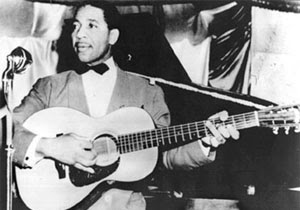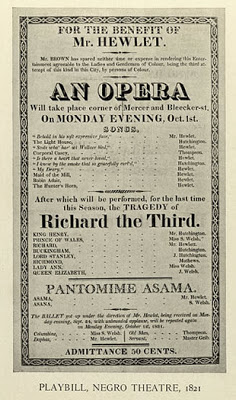Great blues cities No. 5: Memphis.
 |
| Handy’s Memphis Orchestra in 1918. Handy is third from right, back row |
Just
as the first blues ever published (in 1912) was titled, “Dallas Blues”, so the
first blues ever recorded (in 1914) was, “The Memphis Blues.”
which was written and published in Oklahoma City, The Memphis Blues was
actually written in Memphis and published in Memphis to boot. Its composer was
Alabama’s W.C. Handy who had moved his band to Memphis in 1909 to play the
clubs on downtown Beale Avenue, as the street was called then. Black musicians
had been playing on Beale Avenue since the 1860s, with one of the first
ensembles based there being called the Young Men’s Brass Band. Brass band
music, a craze that started in Newcastle Upon Tyne, England, in 1809, moved to
America in the 1830s, where it remained highly popular until around 1920. This
might explain why most of the first blues records were by brass bands or
orchestras.
 |
| Memphis Minnie |
wonderful Memphis Minnie moved from Louisiana to just south of Memphis at the
age of seven, and ran away to busk on Beale Street in 1910. Minnie was just 13.
Born Lizzie Douglas, Memphis Minnie got by playing and singing the blues while
working as a prostitute. Apparently, this wasn’t uncommon for female blues
singers in an era with no social security. Minnie was such a top blues
guitarist she’s said to have outgunned Big Bill Broonzy in a guitar duel in
Chicago in 1933, where she also helped introduce country blues. Minnie’s
‘When The Levee Breaks’, written in 1929, was reworked by Led Zeppelin on Led
Zeppelin 1V in 1971. Here’s a link to Minnie on a 1953 track called ‘Kissing in the Dark’ all
about sexually transmitted diseases:
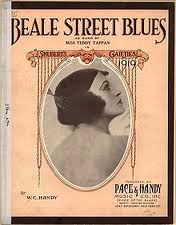 |
| Beale Avenue became Beale Street after this |
Memphis performer from that era, who is now largely forgotten, is Miss Floyd
Fisher, also known as the Doll of Memphis, who toured as far north as New York
City and Chicago, in a double vaudeville act with Baby Seals. You may remember
Baby Seals as the composer of the first published blues with vocals, as
featured in my post of 11 June 2013. His song, ‘Baby Seals’ Blues’ was
published in August 1912, as performed by Baby Seals and Baby Fisher, as the
Doll of Memphis had now become. A description of Miss Fisher appeared in the
African-American newspaper, The Indianapolis Freeman, in 1910: Baby Floyd
Fisher “is the smallest and sweetest little thing on the stage, singing
anything the audience asks. In that way, she holds the house as long as she
wants to.” Apparently, Miss Fisher could do everything from singing and dancing
to male impersonations and cracking up the audience.
a tune to promote a man standing for Mayor of Memphis. His name was Edward “Boss”
Crump and the jingle obviously worked as Crump was duly elected. In 1912, two
songs with a similar structure to Handy’s advertising jingle were published as
blues. This must have stung Handy into action because he then renamed his ‘Mr
Crump’ tune as ‘The Memphis Blues’ and published it. This was the third and
last of the three blues published that first year of the blues: 1912.
pinpoint 1912 as the year ragtime as a genre morphed into blues. While Handy’s original Memphis
Blues sheet
music was subtitled ‘That Southern Rag’, there was no mention
of rags
 |
| Alberta Hunter |
on the record packaging when the song was released as the first blues
record in 1914.
a blues trail by writing blues songs in Memphis until 1917, when he moved to
New York. Landmark Handy compositions, written in Memphis, included ‘St. Louis
Blues’, the song that introduced blues to the world, first published in London
in 1916. From London, ‘St. Louis Blues’ spread around the then British Empire, to
places like Australia, New Zealand, Canada, South Africa and even back to
America. Jazz, at this stage, was still at its embryonic stage, still called
jass, and was a music Handy had little time for. While some people think Handy
invented jazz, he was a 100 per cent blues man and apparently didn’t care much
for jazz at all. In 1916, Handy wrote ‘Beale Street Blues’ which he published
in 1917, inspiring the Memphis authorities to change the name of Beale Avenue
to Beale Street.
Memphis-born blues singer Alberta Hunter (1895 – 1984) co-wrote and recorded the acclaimed, ‘Down Hearted
Blues’, for the black-owned record label Black Swan in 1922. Now aged 27, Alberta
had already performed in Paris and London, back in 1917, so was certainly no Memphis
ingénue.
1923, Bessie Smith made her recording debut covering Alberta’s ‘Down Hearted Blues’,
quickly becoming one of the biggest African-American blues stars of the era,
popular with blacks and whites alike. Many older readers will remember Alberta
Hunter from the 1970s when she came out of retirement aged 83 and sang the
blues classic “Nobody Knows You When You’re Down And Out” on television. But, before
you follow the link to Alberta, here’s one to a mind-blowing version of that
song by Derek & The Dominos recorded in 1970. To me, you just won’t hear
better.
Albert Hunter’s version is a little more sedate than Eric and Bobby’s etc. but
follow this link and you’ll witness a live performance by one of Memphis’s
greatest blues singers. I think the year she was filmed was 1975.
performers between the
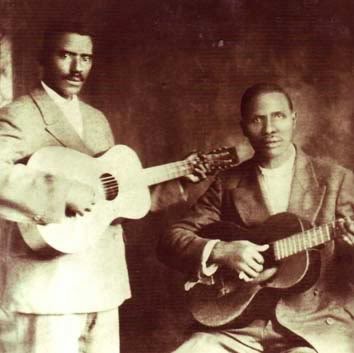 |
| Franks Stokes, right, and his childhood friend, Dan Sane |
1920s and 1940s. Such musicians helped create the style
now known as Memphis Blues. Frank Stokes, born just outside
Memphis in 1888, is still considered by many as the Father of Memphis Blues
Guitar. In 1927, aged 39, Frank got together in Memphis with Dan Sane, 31, to
record as the Beale Street Sheiks. The fluid interplay between Stokes and Sane,
their propulsive beat, witty lyrics and Stokes’ stentorian voice make their
recordings irresistible, says a local Memphis guide book. Here’s a link to the
Beale Street Sheiks recorded in 1927.
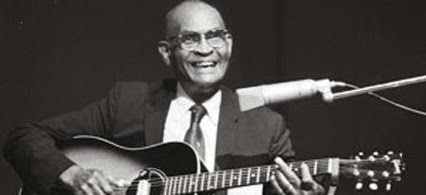 |
| Rev. Robert Wilkins (1896-1987). Rediscovered in the 1960s. |
Wilkins, a guitarist of African-American and Cherokee descent (like so many
early bluesmen), who could be heard playing blues and gospel on Memphis radio
in 1927. Born 21 miles outside Memphis, Wilkins claimed to have tutored the
great female blues guitarist, Memphis Minnie, and also worked alongside a W.C.
Handy protégé, Walter ‘Furry’ Lewis, also from Memphis.
Lewis (1893 – 1981) is worth mentioning because he spectacularly opened for the
Rolling Stones, aged 81, on American TV’s The Tonight Show Starring Johnny
Carson, in 1974.
Memphis was also a great city for jug bands, including Will Shade’s Memphis Jug
Band, which often included Memphis Minnie on vocals and guitar. They played
slow blues, hokum (humorous, raunchy blues), pop and dance tunes. While the
first jug bands came from Louisville, Kentucky, the Memphis Jug Band made over
80 recordings between 1927 and 1934, making them America’s most recorded
pre-WW2 jug band. Another popular Beale Street jug band, and there were many,
was Gus
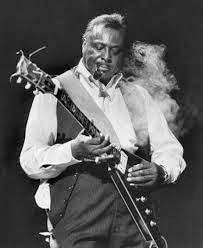 |
| The smokin’ blues of Albert King |
Cannon’s Jug Stompers who recorded ‘Walk Right In’ in the 1930s, a song
more recently made famous by Dr. Hook (or Dr. Hook and the Medicine Show as I
remember them in 1972, when I helped promote ‘Sylvia’s Mother’.
blues legends who played on Beale Street between 1920 and 1940 included Louis
Armstrong, and Rufus Thomas who moved to Memphis at the age of two. Then there was Memphis Slim (born John Chapman in
Memphis, in 1915) who moved to Chicago in 1939 where he became Big Bill
Broonzy’s piano player. Chapman was given the nickname ‘Memphis Slim’ by Lester
Melrose in 1941 when recording ‘Grinder Man Blues’ and other songs; but used
his father’s name, Peter Chapman, for many of his compositions. These include
‘Every Day I Have The Blues’, recorded by Ray Charles, Eric Clapton, Jimi
Hendrix and a host of other blues and jazz luminaries.
World War Two, when thousands of African American musicians were forced from
the Mississippi Delta by poverty, many made their home in Memphis, changing the
old classic Memphis Blues Sound to a sound more familiar today. These musicians
included the velvet bulldozer, drummer and magical blues guitarist, Albert King;
Howlin’ Wolf; Ike Turner and
King, originally billed as the ‘Beale Street Blues Boy’.
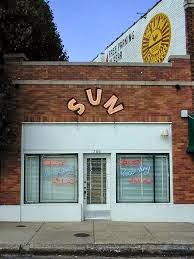 |
| Memphis’ most famous building? |
 |
| Not the first rock & roll record |
gained the attention of the world after Sam Phillips opened his Sun Studios in
the city in 1950, recording then amateur bluesmen like B.B. King, Howlin’ Wolf
and Junior Parker. He also recorded a 19-year old Ike Turner performing ‘Rocket
88’ as Jackie Brenston and his Delta Cats, released in 1951, often wrongly
described as the first rock & roll record. Ever the publicist, I suspect it
was Sam Phillips himself who started that rumour. You only have to check my
archives and read the post of 8 August 2013 ‘Ten Rock & Roll Records (of
the 1930s and 40s) That Pre-empted Rock & Roll’ to see how hollow a claim
that was.
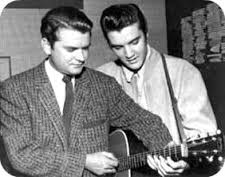 |
| Sam Phillips and his protege |
was Phillips recording of black bluesmen who put Memphis in the world spotlight
of course. It was his idea to get a white boy who sounded like a black bluesman
to make a record in Memphis in 1954. That white boy, as we all know, was Elvis
Presley, and the world was never the same again.
http://www.amazon.co.uk/s/ref=nb_sb_noss?url=search-alias%3Ddigital-text&field-keywords=how+blues+evolved+volume+one
